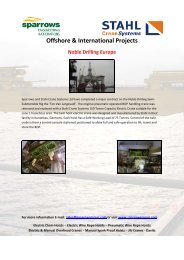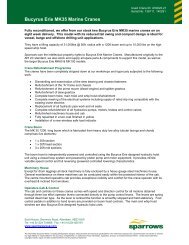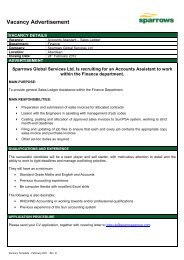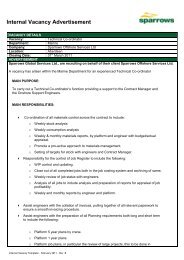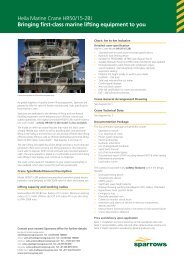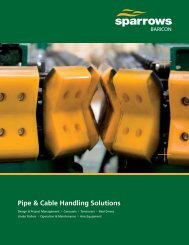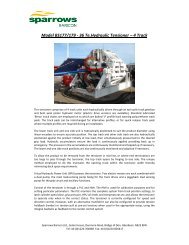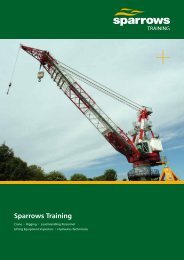EC2030 Onshore Mobile Crane Rigging - Sparrows
EC2030 Onshore Mobile Crane Rigging - Sparrows
EC2030 Onshore Mobile Crane Rigging - Sparrows
Create successful ePaper yourself
Turn your PDF publications into a flip-book with our unique Google optimized e-Paper software.
ONSHORE RIGGER TRAINING<br />
2 Day<br />
Contact: <strong>Sparrows</strong> Training Department Tel: 985-873-7969<br />
Course Overview:<br />
This course will provide the skills necessary to evaluate loads, select the appropriate hitch and<br />
hardware for performing the lifting of loads. Personnel will learn techniques to perform daily<br />
inspections, assess rigging safety, and properly communicate with other riggers and to ensure<br />
overall safety during material handling/lifting processes. Those attending this training will learn<br />
operating principles, operational safety, load control methods, inspection procedures,<br />
communications, and load handling techniques. As the training includes some hands-on<br />
activities involving rigging and moving loads, you are expected to provide personal protective<br />
equipment such as a hard hat, gloves, safety glasses, and steel toe shoes.<br />
Designed For:<br />
This course is designed for personnel seeking training that meets ASME B30 and OSHA<br />
standards.<br />
Riggers are personnel that work onshore, dock/warehouse personnel, maintenance and<br />
operations type personnel, or others that frequently attaches slings and lifting gear to<br />
equipment/material to be lifted by crane, hoist, etc.<br />
Objectives:<br />
Upon completion of this course participants should be able to:<br />
<br />
<br />
<br />
<br />
<br />
Identify proper rigging components<br />
Select correct rigging equipment<br />
Select correct hitch applications<br />
Inspect rigging hardware<br />
Perform basic rigging calculations<br />
Outline:<br />
1. <strong>Rigging</strong> Hardware:<br />
a. Sheaves, Blocks.<br />
b. Hooks, Safety Latches<br />
1
c. Rings, Links, Swivels<br />
d. Shackles<br />
e. Turnbuckles<br />
f. Spreader and Equalizer beams<br />
g. Cable clips<br />
h. Pad eyes, eyebolts, other attachment points<br />
2. Slings:<br />
a. Sling configuration<br />
b. Sling angle<br />
c. Safe working limits<br />
d. Sling types (synthetic, wire, chain, etc)<br />
e. Cargo nets, baskets<br />
3. <strong>Rigging</strong> Basics:<br />
a. Pinch points/body position<br />
b. Personal Protective equipment (PPE)<br />
c. Signals/communications<br />
d. Load stability<br />
4. Procedures and Precautions:<br />
a. Load control/tag lines<br />
b. Lift Planning<br />
c. Inspection/rejection criteria<br />
d. Unbinding loads<br />
e. Personnel transfer<br />
f. Sling handling and storage<br />
5. Loose Lifting Equipment Basic Operation Overview<br />
a. Winches<br />
b. Come-a-longs<br />
c. Hoist<br />
d. Beam Clamps<br />
e. Trolley Beams<br />
f. Winches<br />
g. Hoist<br />
6. Hands-On Exercises<br />
7. Written Examination<br />
2




